“KIT Lab,” set up within KPMG Ignition Tokyo, is an R&D team which constantly monitors information on the latest technology and carries out studies to apply next-generation technology to business lines and accelerate its commercialization. It is also researching and developing various solutions to support the digital transformation (DX) of KPMG Japan by setting six focused areas, namely, secure computing, knowledge processing, intelligent agents, scientific visualization, smart transactions, edge computing and IoT.
In this article, we will introduce visions and fantasies regarding “how new technology will affect corporate management in ten years’ time” that is shared by KIT Lab members.
*Professional affiliation and official position in the article are at the time of publication.
Contents
- Secure Computing Helps Companies to “Collaborate” Externally
- Knowledge Processing Will Bring “Discontinuous Change” to Companies
- Intelligent Agents Will Change the “Way Companies Operate in Society”
- Companies Will Be able to “Forecast More Elaborately” with Scientific Visualization
- Smart Transactions Will Realize “Real-time Management”
- Edge Computing and IoT Will Enhance “Automaticity of Company”
- “Mobility and Robotics” Will Follow the Six Technology Areas
- Image of Corporate Management in Ten Years’ Time Starts with “Fantasizing”
Secure Computing Helps Companies to “Collaborate” Externally

6 Areas of Service provided by KPMG Ignition Tokyo
Chatani: Today, I would like to talk about “corporate management in ten years’ time” with members who play central roles at KIT Lab. First of all, please tell us about your vision on how technology will affect corporate management in ten years’ time in your respective areas of specialization.
Toyota: I thought about what kind of impact secure computing will have, especially secret computation and blockchains.
First of all, as a premise, I expect that new collaboration between companies will further advance going forward because the strategies adopted by companies to minimize their asset holdings in recent years will become more common going forward. This means that in the manufacturing industry, manufacturers will specialize in enhancing their brand value while entrusting the actual manufacturing work to suppliers.
In that case, each company will further expand collaboration beyond their own scope to further enhance their brand values through collaboration between brands. I think that secure computing and blockchain technology will be necessary in such an environment.
Currently, what is obstructing collaboration between companies is that we cannot freely share data that are subject to privacy and data protection or confidentiality that will become a problem if leaked to competitors.
However, by using secure computing technology, it will be possible to sugarcoat confidential data belonging to each party and combine and aggregate them without melting the sugarcoat to implement benchmark calculations. This should contribute greatly to the ecosystem.
As for blockchains, the technology itself is extremely “rebellious,” and it is considered to be in opposition to the so-called centralized way of thinking. It is like coordinating a group of ants to build a nest by having each ant understand their respective objective and role, rather than relying on one core. This movement is starting to become the trend in the world of business and I am very much looking forward to seeing how it will develop going forward.
Chatani: As for secure computing, its use in the area of sustainability is likely to accelerate. As integrated reports will not only include information held by the company but also reflect information held by other companies including the supply chain, and various information related to the company’s employees, it will probably be necessary to collect scattered information which is encrypted to some level.
The more decentralized managed statistical relationships become, and the more the organization or business has highly mobile players acting dynamically, the more we can expect centralized databases to become less convenient to use. In such a situation, blockchains will have great value as a decentralized database and probably serve as a major pillar in promoting digitalization going forward.
Knowledge Processing Will Bring “Discontinuous Change” to Companies
Chatani: Next is knowledge processing. What kind of impact do you think it will have in the areas of digital technology and corporate management in the next ten years?
Chiba: As a knowledge processing engineer, I think that if routine work is automated in sequence, this may eventually lead to the automation of corporate management and corporate strategy formulation.
Automation has been advancing in various areas in recent years. For instance, airline check-in counters have changed to self-service kiosks while automation utilizing machine learning and deep learning is already being promoted in creative fields as well. Even music composition and text generation of novels are becoming possible with automation.
This is why I believe that a system which will search through data and find a road map that indicates the way “in the case of this pattern” and make recommendations on corporate management and corporate strategy will be created going forward. I also think that the roles human beings will play in such an environment will become important.
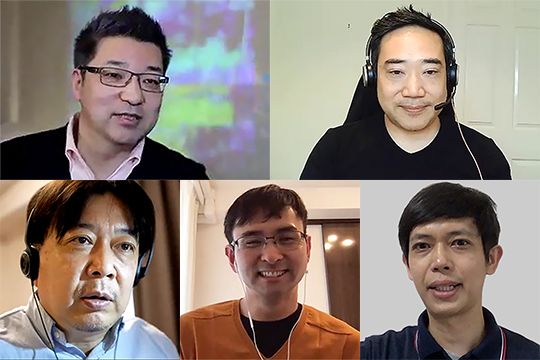
KIT Lab Members
After all, I think that human beings, who can use various analogies, are better at what computers cannot cover, such as “unprecedented matters” and “situations that require intuitive judgement,” where solutions cannot be worked out based on statistical information. Only humans can probably think of ideas that machines cannot come up with, such as “there may have been this kind of pattern in the past.”
Chatani: You just talked about AI composing music, but I am a bit disappointed with this. For example, having AI create Mozart-style music by learning data that include the music of Mozart, I feel, is an “editing task.” If AI is able to create Mozart-style music by learning the music that was created before Mozart was born, only then can it be considered as creative. This also goes for paintings by Monet or Picasso and a sport derived from some other sport.
I think that there will be a breakthrough in machine learning in the process of creating this music and these paintings.
Chiba: You’re right. What’s appealing about Mozart’s music is the process of a person who felt rigidity in the formality of classical music creating romantic music and creating something new from being bored with what was a routine style. As it stands now, this is an area where human beings still perform better.
Chatani: In a way, it will be interesting to see if AI can create an abnormal change or discontinuous change. I look forward to seeing this someday and I hope that this will emerge from the knowledge processing of KIT Lab, which Chiba-san is in charge of.
Intelligent Agents Will Change the “Way Companies Operate in Society”

Masatake Toyota, Lead Director of Secure Computing / Intelligent Agent, KIT Lab
Chatani: I would like to hear about intelligent agents next. I believe this is the area Toyota-san is in charge of.
Toyota: In the intelligent agents area of KIT Lab, we are doing research on agents with intelligent sense, which enables smooth communication with humans based on aggregated information in a specific field. This technology is already familiar, as chatbots are already used at call centers.
What comes next, I guess, is avatars. After all, we feel secure if we receive responses from avatars with a human face. Communication that is faster than written communication will probably be the next stage. Situations where avatars understand everything and make quick responses without having to write things down are already starting to be realized.
If avatars are implemented two to three years from now, I imagine that placing a “digital me,” a replica of myself, in a virtual space such as a digital twin and have it work on behalf of myself will become a paradigm in ten years’ time
Even if that is not fully realized, fusions between virtual and reality spaces will accelerate considerably and I think that working styles and, moreover, the roles of companies in society will change. In particular, the fact that teleworking due to COVID-19 has enhanced productivity will surely boost this movement.
In such an environment, I believe that the secret computation and encrypting technologies of secure computing that I mentioned earlier will stimulate the exchange of information, encourage collaboration among companies, and create a market that finds more value in the exchange of information.
Chatani: When we think of intelligent agents, I think there are several ways in which they are clearly superior to human beings.
The first point that comes to my mind is “their persistence to continue taking on challenges without being discouraged.” It is noteworthy that as long as power is supplied continuously, they will not feel any strong psychological burden. I expect that this will lead to the possibility of being able to replace humans when dealing with various social issues, for instance, doing “tasks that should not be carried out by humans” such as screening negative content on the web including social media.
The other point is that they can selectively forget information. By pulling out specific knowledge and reinstalling them or rebooting them, they can be rewritten with a new memory system. It will therefore be possible to respond better, for instance, to legal changes regarding auditing and tax services and to deal with revisions that are applied at a certain time such as “from April 1 next year” without making any mistakes.
In this respect, it will be possible for computers to support auditing and accounting services.
Companies Will Be able to “Forecast More Elaborately” with Scientific Visualization
Chatani: The area of scientific visualization also varies widely and the impact it will have on corporate management seems to be wide-ranging as well.
Chiba: That’s true. What I always think about are two things.
The first is immersion. Various displays such as large-sized screens, VR and AR have been used in recent years and high-immersion displays will continue to be developed going forward. I am interested in how they will be utilized in corporate management.
The other is the real-time feature of data. For instance, it is possible to measure and grasp one’s own health conditions in real-time by using an Apple Watch. If this can be applied to understanding the business conditions of companies that change from hour to hour, it may be possible to resolve the time lag issue in financial statements, which are currently compiled on a quarterly basis. Also, we will be able to acquire various insights if these data can be monitored not just as financial statements but from various perspectives utilizing VR devices.
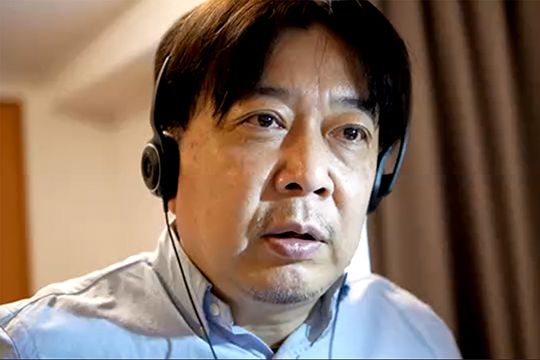
Naoki Chiba, Senior Manager of Knowledge Processing / Scientific Visualization / Edge Computing & IoT, KIT Lab
Chatani: I also think that an extension of this idea is a future where it will be possible to monitor the growth process of a company on a simulator using a digital twin of the company. We have been simulating the growth of companies using only abstract information such as sales and profits, but I expect that it will be possible to make more elaborate forecasts going forward.
Although this idea has been around for a while, it has finally become possible to prepare enough data space and computing capacity to realize it. For instance, it may become possible to look at blueprints of several scenarios to make decisions at management meetings.
However, there are points we must keep in mind regarding simulators. Even if the mock-up is life-size, things that need to be seen may not be visible if they are not viewed in the same environment. Though visualization is highly useful, it will not be possible to find management indicators unless the actual logistics and business movements can be visualized. Also, data are essential for contributing to such visualization and so the prevention of manipulation, secure computing and encryption technology using blockchain will be indispensable for collecting these data.
Toyota: After all, as they say, “Rubbish In, Rubbish Out.”
Chiba: Such devices that realize unprecedently complex and advanced visualization are also evolving rapidly. I expect that the world of visualization will also change from this perspective.
Smart Transactions Will Realize “Real-time Management”

Shungo Miyabe, Senior Scientist of Smart Transaction, KIT Lab
Chatani: Now, please tell us about the impact smart transactions will have in the next ten years. Miyabe-san, can you tell us about this?
Miyabe: I think there are two key points. One is regulation. Currently, as auditing firms and banks are keeping their data tightly guarded, they cannot be shared. However, when we look at financial crimes and accounting fraud in recent years, cases where suspicious transactions could not be detected just by looking at the transaction data of one company in a certain database have been increasing.
That’s why I think it is necessary to prepare an environment that can mutually share data and ensure transparency utilizing technologies in the area of secure computing. In order to achieve this, a revision of regulations is unavoidable, even though this is difficult. I expect that this problem will be overcome and real-time fraud detection will be possible in about ten years’ time.
The other key point involves the technology part. In the field of quantum computing, which I am in charge of, the number of qubits is continuing to increase. Therefore, I think that in ten years, it will be possible to carry out real-time auditing in an extremely secure way using a computing platform that will change the paradigm.
Chatani: If it can be realized in real-time, the current system of conducting auditing and tax inspections after the accounting term has ended will probably change. It may become possible to conclude auditing and tax inspections the moment the accounting term ends.
Miyabe: That’s right. Also, the process of conducting them will change as well. The process of someone compiling data and handing them to those in charge of auditing and tax services will change to a process where services are conducted while looking at the data that are uploaded in real-time. If so, the management process should also continue to change.
However, while technologies will advance at an accelerating pace, will regulations change as well? I feel that this will be the future challenge.
Edge Computing and IoT Will Enhance “Automaticity of Company”
Chatani: Let’s move on to the last pillar, which is edge computing and IoT. I believe that they will have a great influence on corporate management. How do you see this, Chiba-san?
Chiba: In the field of edge computing and IoT, I expect that both networks and edge devices will evolve. The issue will then be how to maintain a balance amid the expansion of their respective capabilities.
It is often difficult to know where and what to calculate and how to place it in the most cost effective way for the system, or whether it will have a favorable impact on performance, without actually doing it. I think there will be cases where things that could not be done before will become possible.
While various demonstration experiments have been carried out in the past ten years, it has now become possible to connect to networks in device-rich environments and also connect to the Internet at an extremely low cost. We will be repeating the process of “mapping out ideas and putting them to practical use” going forward and I expect that various ideas will be used in areas we are unaware of in ten years’ time.
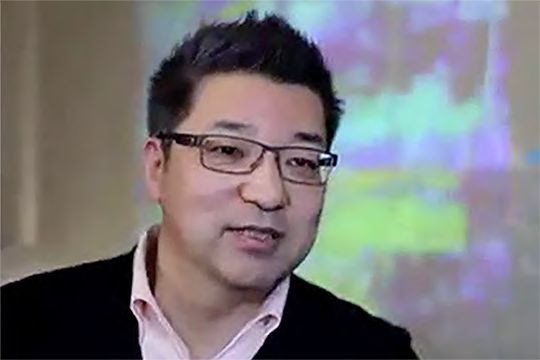
Masayuki Chatani, Representative Director & CEO of KPMG Ignition Tokyo and CDO of KPMG Japan
Chatani: For example in overseas countries, surveillance cameras have been set up across the city and there are cases where the image data are used to prevent crimes and contribute to the early arrest of criminals. These devices used to be operated by remote control but it has recently become possible to complete operations on the devices using software. As various devices are becoming available, applications that use them seem to be expanding as well.
However, as many people are starting to have sensing devices and have started to assume the work of police authority, the legitimacy of images and data themselves is beginning to be questioned. This is because it is not so difficult to create fakes. I feel that this will become our future challenge.
On the other hand, as devices can be controlled using Bluetooth recently, there is no need to go through the process of pressing the switch each time any more. If this continues to evolve, the entire company may become more automatic.
“Mobility and Robotics” Will Follow the Six Technology Areas
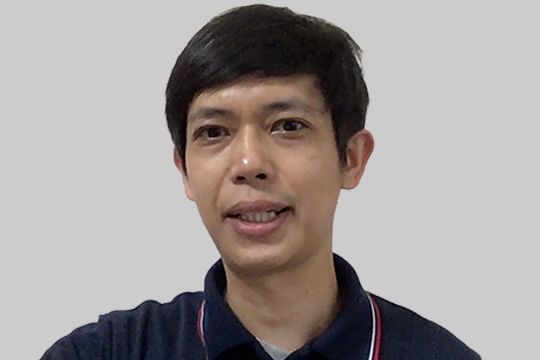
MaungMaung Thant, Senior Manager of Lab Engineering, KIT Lab
Chatani: Maung Thant is in charge of engineering, which constitutes various elements in the six technology areas. From your standpoint, what do you think corporate management will be like in ten years’ time?
Thant: In ten years, I expect that technology will advance further in the context of data volume continuing to increase. So, how will we commercialize those data? KIT Lab’s framework is like a pipeline that is shaping research and development aimed at commercialization. If this results in enabling experiments to be carried out flexibly and easily, it will be possible to combine different technologies and identify the predictability level of the most suitable solution and EI (emotional intelligence) model.
The issue regarding data will be how to find novelty in data and which data can be utilized to create value. We are focusing on six technology areas but we will probably be confronting the question of whether we can create new products by combining different technologies. This will probably be possible if there is “something” that connects these technologies. The key will be how to combine different services to create new things and innovations.
Chatani: So, what do you think will be the seventh technology that can be added to these six technology areas from the standpoint of an engineer?
Thant: As Chiba-san pointed out, I think that a virtual environment with a sense of immersion where AI and human beings can work together will become common in ten years’ time. The new technology that will be required in this context may be to understand and learn consumer behavior. This used to be called Human Computing Interaction (HCI) but I think human-intelligent technologies will be interacting more with each other. This should become an interesting technology area.
Chatani: I see. In my opinion, I see mobility and robotics as a match for the seventh area. Though it seemed premature when considering the current six technology areas, I think it will be possible in the next stage. For instance, there are cases where auditors need to physically check the existence of inventory or real estate to confirm its verifiability. This is an area of research and development that involves utilizing robots to replace people when visiting a site for an investigation.
Thant: That’s a good point. It will be possible to apply robots in remote auditing as well as have them carry a camera and pen and walk around the office, introduce an avatar and agent and have them interview people in the office or collect information and hand it to the auditors. I think this way of using them is very interesting.
Chatani: We sometimes receive requests whether it is possible to carry out auditing using drones with cameras. A robot should be able to go to the site many times and move “voluntarily” to places that requires investigation.
Thant: If this is realized, our robots will serve as partners of auditors. It may also be possible to participate in meetings and conversations to collect information for internal auditing.
Image of Corporate Management in Ten Years’ Time Starts with “Fantasizing”
Chatani: The fusion of advanced digital technologies is also becoming one of the themes at KIT Lab. I would therefore like to hear your ideas on how technologies across all areas will change corporate management in ten years’ time.
Miyabe: There is a calculation method called first-principles calculation in my primary area of expertise. It can handle only a small number of atoms and it is said that the only atom it can give a correct answer to is the hydrogen atom. However, with the evolution of quantum computing, it may become possible to calculate even complex proteins. Then, it may be possible to calculate the component materials of the entire human body in the future. If we expand this idea a little bit, the simulation of the world may become possible and the so-called DNA of companies may also become computable.
Chatani: If this becomes a reality, it may be possible to use quantum computing to find out that “an extremely interesting type of DNA can be created by mixing the DNA of this company and that company!”
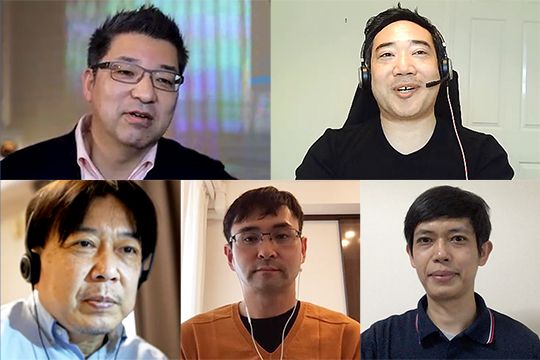
KIT Lab Members
Currently, experts are providing advice on M&A based on the complementary nature of business portfolios but it may become possible to measure post-M&A benefits in a more in-depth way. It may also become possible to see “how harmonization will be after a merger” by mixing not just the DNA of companies but also their environment and employee information.
As an M&A service that conducts such matching work can only be carried out with computers, I think that the entry barrier is not so low.
Toyota: Although this is out of my area of expertise, I am focusing on the evolution of technology regarding the senses of smell and touch among the five senses people have. In particular, when the sense of smell is stimulated, it sometimes recalls events that occurred in the past. It would be very interesting if we could use this reaction to create a business application which can distinguish whether investigation records and documents are fake from the smell of the paper.
One more thing I would very much like to try once is to borrow algorithms devised by other people; in other words, to experience the conceptions of Chiba-san and Chatani-san while having my own awareness.
Chatani: This theme is often taken up in science fiction and Japanese animations.
Toyota: If this were implemented, there would be various compliance issues such as privacy but it is incredibly intriguing.
Chatani: I am also interested in the “future of education.” If STEM (Science, Technology, Engineering and Mathematics) becomes the center of education going forward, things we have to memorize will probably change. More fundamental principles and how basic formulae were formed will become important while memorizing the years of historically important events will have less meaning. Instead, emphasis will be placed on why such events occurred. I believe there will be more opportunities to learn about wide and historical perspectives.
Toyota: The approach to analyze the patterns of past events from various perspectives so that they will not be repeated again will also be possible. However, in order to prevent events that are likely to occur but have not, such as fraud that has not yet occurred, I think we will have to rely on methodology after all.
Chatani: Although there is a certain amount of knowledge recorded about situations where fraud is likely to occur, I imagine that only some of this knowledge remains in digital form. As there are few cases where the modus operandi is publicized in detail, there is probably not much data that is accessible.
However, this may be a “gold mine” which may lead to the prevention of fraud. In this sense, we must discuss whether the possession of data by individual auditing firms and banks is really beneficial for society, as indicated by Miyabe-san. It may be more beneficial for society as a whole if we could encrypt and disclose data to each other.
We can go on talking, but I think envisioning and fantasizing repeatedly will serve as good opportunities to find out “what we should do going forward.” Let’s hold a series of such discussions, combine our professional knowledge and continue to take on unprecedented challenges.
※ Professional affiliation and official position are at the time of interview.
Follow us on KPMG Ignition Tokyo LinkedIn for the latest news.
Connect with us
- Find office locations kpmg.findOfficeLocations
- kpmg.emailUs
- Social media @ KPMG kpmg.socialMedia




